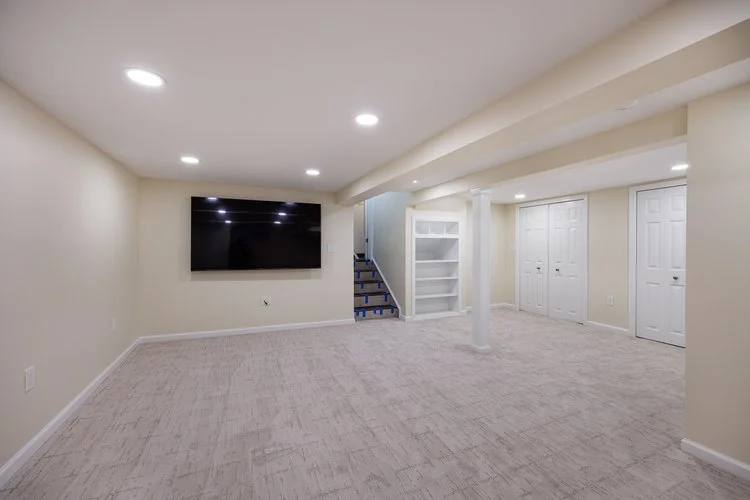How to Pay for Basement Remodel – Budget Without Stress
Thinking about remodeling your basement but worried about the cost? You’re not alone. A basement remodel can add serious value to your home, but paying for it isn’t always simple. The good news?
You’ve got options, whether you're working with savings, looking into financing, or trying to stick to a strict budget. From personal loans to home equity lines, we'll break down the most realistic ways to fund your renovation.
No fluff. Just clear, practical advice to help you get started. If you're ready to turn your basement into something better—without breaking the bank—this guide is for you. Let’s dive in.
How can you pay for a basement remodel?
Use savings, home equity loans, HELOCs, cash-out refinance, personal loans, credit cards, or contractor financing.
Key Takeaways
Average basement remodel cost: $25,000–$75,000+
Budget with a 10–20% cushion for surprises
Top financing options: savings, home equity loans/HELOC, cash-out refi, personal loans, credit cards, contractor financing
Always compare rates, fees, and monthly payments
Why Remodel Your Basement?
Your basement’s basically free real estate. Turn it into a home office, gym, theater, or just a spot to vibe. It’s the cheat code for more room without moving.
A finished basement also flexes on appraisers, boosting your property value so buyers pay up. Want extra income?
Rent it out or go Airbnb and let that dark storage zone pay your mortgage. Or just upgrade your lifestyle with poker nights, movie marathons, or a killer bar. Why pay for someone else’s scene when you can build your own?
Average Cost of a Basement Remodel
Let’s talk numbers without the sugarcoat. Finishing a basement usually runs $25,000 to $75,000. Want that luxe home theater or a rental unit with all the drip?
Budget closer to six figures. It really depends on size, finishes, and how fancy you want to flex. Don’t forget permits and surprise costs that love to crash the party.
Best move? Get solid quotes and pad your budget by 10 to 20 percent. No one likes calling the bank mid-reno because you ran out of cash.
How to Plan Your Basement Remodel Budget
First rule? Don’t just wing it. Break down every cost so you know where your cash is going. Labor, materials, permits, design fees, even the fancy bar you’re eyeing.
Get quotes from contractors. Compare them like you’re hunting for the best sneaker drop. Lowball bids can mean cut corners.
Set a budget that actually makes sense for your space. Small cosmetic upgrades cost way less than turning it into a full rental unit with kitchen and bath.
Always add a 10 to 20 percent cushion. Surprises will show up like uninvited guests at your BBQ. A hidden leak or extra framing work can kill your vibe and your wallet.
And keep it real about your priorities. Do you need custom everything or can you flex with some smart IKEA hacks? A solid plan saves you from calling your credit card in a panic halfway through.
Top Ways to Pay for Your Basement Remodel
1. Personal Savings
This is the cleanest flex. No banks. No interest. Just you funding your own glow-up.
If you’ve been stacking cash, using it here saves you loan fees and monthly stress.
But don’t drain yourself dry. Keep an emergency fund so one remodel doesn’t wreck your safety net.
Think of it like buying a grail watch. Feels better when you can actually afford it without selling your sneakers.
2. Home Equity Loan
Your house is your piggy bank. A home equity loan gives you a lump sum, secured by what you already own.
Fixed rates keep payments predictable. You’ll know exactly what’s due each month.
It’s smart if you need a big chunk up front for contractors.
But don’t forget you’re putting your house on the line. Miss payments and the bank’s knocking.
3. Home Equity Line of Credit (HELOC)
This is like having a credit card tied to your home’s value. You get a flexible line you can pull from as you need it.
Perfect if your remodel drags or you pay in stages.
Rates are usually lower than personal loans or cards.
But they can be variable, so watch out for rate hikes.
Pro move? Only borrow what you actually need. Don’t go full “kid in a candy store” just because the credit is there.
4. Cash-Out Refinance
This is a big-boy move. You replace your mortgage with a new one for more than you owe, then pocket the difference in cash.
It’s solid if rates are decent or you want to consolidate higher-interest debt.
Plus, it can net you a fat sum for a major basement overhaul.
But closing costs hit hard. You’re also resetting your mortgage clock.
It’s like trading in your daily driver for an upgraded model with a bigger loan. Make sure you’re cool with the new payment.
5. Personal Loans
Quick, easy, and unsecured. Banks or online lenders love to offer them for remodels.
No home as collateral means less risk to your property.
But interest rates can be spicy, especially if your credit score is mid-tier.
They’re best for smaller projects where you want to keep it simple.
Think of this like buying a Vespa instead of a car. It gets you there, but you’re not hauling granite countertops on it.
6. Credit Cards
High risk, high reward if you’re careful.
0% intro APR offers can be a cheat code for short-term financing.
But don’t carry a balance past the promo period unless you like 20%+ interest rates.
Use them for small stuff or bridging gaps in cash flow.
Treat it like that flashy suit you only wear for weddings. It’s not for daily wear unless you want trouble.
7. Contractor Financing
Some pros offer payment plans right through them. Super convenient.
You skip the bank drama and get it all in one deal.
But read the fine print. Rates can be worse than other options if you don’t check.
It’s like buying a car at the dealership. Sure, they’ll finance you, but they’re making money off the loan too.
Great for quick approvals, but always compare with other methods so you don’t overpay for the drip.
Final Word on Picking Your Option
Don’t just jump at the first offer. Compare rates, fees, and monthly payments like you’re shopping for sneakers.
Each method has its vibe. Pick the one that actually fits your budget and goals.
Because the real flex? A finished basement you can afford without losing sleep.
Comparing Your Financing Options
Don’t just grab the first loan like it’s the last slice of pizza. Each option has its own vibe.
Home equity loans and HELOCs usually mean lower rates, but you’re betting your house. Personal loans keep it unsecured, but rates climb if your credit isn’t stellar.
Cash-out refi can score you big cash, but it resets your mortgage clock. Credit cards? Only smart with 0% promos, or you’ll pay out the nose.
Contractor financing is easy, but can be sneaky on rates.
Check interest, fees, and monthly hit. Choose the one that fits your budget without killing your drip.
Tips to Reduce Basement Remodel Costs
Don’t blow the whole bag on marble and neon signs. Start by getting multiple bids so contractors know you’re not an easy mark.
Do some work yourself if you’re handy. Even demo and painting can save stacks.
Reuse or flip materials. Salvage yards are your secret weapon for cheap drip.
Plan in phases instead of going all-in day one. Spread the cost so your wallet can breathe.
And keep the design realistic. That Pinterest mood board? Cool. But champagne taste on a beer budget needs smart swaps.
If you're adding a dormer in Freeport as part of your basement game plan, it can eat up budget fast. Keep it practical—think light and headroom, not over-the-top drama—and your bank account will thank you.
Mistakes to Avoid
Don’t skip the budget talk. Winging it means blowing cash on stuff you don’t need.
Avoid the cheapest contractor just to save a buck. You’ll pay twice when the work falls apart.
Ignoring permits? Big mistake. That’s fines, headaches, and maybe ripping it all out.
Don’t forget to plan for surprises. Hidden leaks or sketchy wiring love to pop up uninvited.
And don’t get too fancy if you’re planning to sell soon. Keep the flex realistic so buyers actually want it.
Conclusion & Final Advice
Remodeling your basement isn’t just a flex. It’s a real move to boost space and value.
But don’t just throw money at it blind. Plan your budget, know your financing options, and stay sharp about costs.
Pick the right payment method that won’t choke your monthly vibe. Compare rates like you’re hunting for the perfect watch.
Be ready for surprises. Don’t skip the boring stuff like permits. And keep the design in check so it’s actually worth it if you sell.
Bottom line? Treat your remodel like any big buy. Thoughtful, stylish, and paid for smart so you can actually enjoy the finished space with a cold one in hand.


